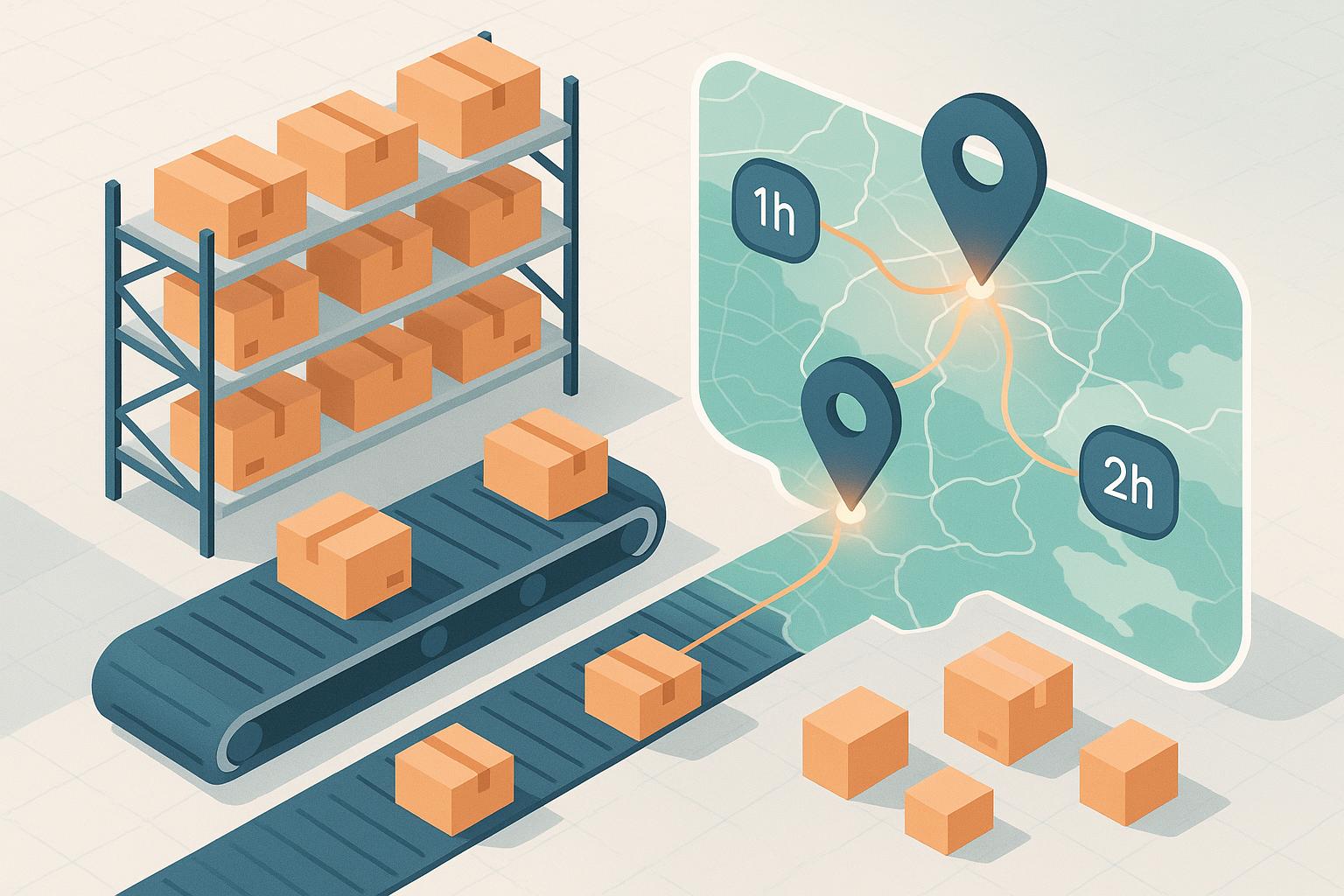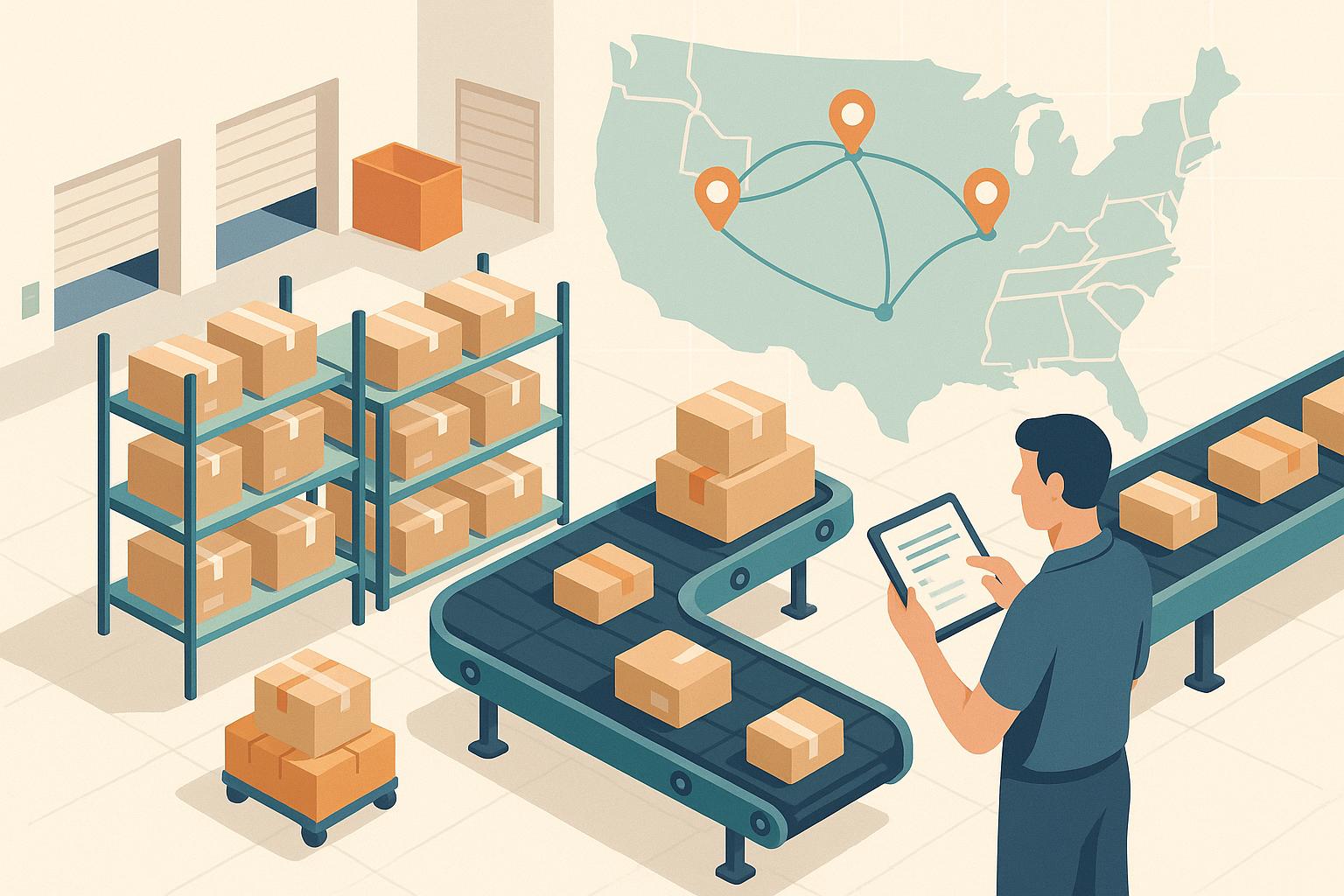3PL providers are transforming warehouses to reduce environmental impact while maintaining efficiency. They focus on energy-saving systems, waste reduction, and advanced technology to support brands in meeting consumer and regulatory demands for greener operations. Here’s how they do it:
- Energy Efficiency: Use of LED lighting, solar panels, and smart HVAC systems reduces energy use by up to 30%.
- Waste Reduction: Recycling programs, reusable materials, and eco-friendly packaging cut landfill waste and lower costs.
- Green Tech: Warehouse management systems and route optimization tools minimize emissions and improve delivery efficiency.
- Collaboration: Brands and 3PLs align on shared goals, track progress, and invest in renewable energy and sustainable logistics.
Platforms like Forthmatch help brands compare logistics partners based on their green practices, ensuring alignment with sustainability goals.
Exploring the sustainability role of 3PL providers
Energy-Efficient Warehouse Operations
Building on the environmental and cost advantages previously mentioned, energy-efficient operations are a key component of sustainable 3PL warehousing. By upgrading lighting, improving HVAC systems, and leveraging smart automation, 3PL providers can make a meaningful reduction in their environmental impact.
LED Lighting and Renewable Energy
Switching to LED lighting has become a cornerstone of energy-efficient warehouse operations. LEDs not only consume less electricity, but they also last longer, reducing maintenance demands. Plus, they’re compatible with smart controls, which allow for adaptive brightness based on operational needs.
Solar panels are another popular solution for 3PL warehouses. The large, flat rooftops of these facilities are perfect for solar installations, making it easier to generate clean, renewable energy.
Together, LED lighting and solar power create a powerful combination. Solar panels produce electricity during sunny hours, while energy-efficient LED systems ensure that power is used wisely throughout the day. This synergy extends to other systems as well, like HVAC, which can further enhance energy efficiency.
Smart HVAC Systems and Temperature Control
Traditional HVAC systems often waste energy by heating or cooling areas that don’t need it. Smart HVAC systems solve this problem by using sensors and automation to adjust temperature and airflow based on real-time conditions and occupancy levels.
These systems monitor factors like workforce presence, equipment-generated heat, and outdoor weather. This allows them to fine-tune climate control, ensuring optimal storage conditions for goods while minimizing energy waste. For temperature-sensitive products, such as perishables or pharmaceuticals, this level of control is essential for maintaining quality.
Smart HVAC systems also improve working conditions for employees, which can lead to increased productivity. Instead of heating or cooling the entire warehouse uniformly, these systems focus on specific areas, reducing energy use while keeping operations efficient. Paired with automation, these systems take energy efficiency to the next level.
Automation and Robotics for Efficiency
Automated Storage and Retrieval Systems (ASRS) and robotic technologies are reshaping how warehouses manage energy consumption. These systems reduce the need for extensive lighting in storage zones and optimize the use of climate-controlled spaces.
Robotic picking systems and automated conveyor networks focus activity in smaller, highly efficient zones. This allows less active areas of the warehouse to operate with minimal energy requirements.
The use of lithium-ion batteries in material handling equipment further enhances efficiency. These batteries last significantly longer than traditional lead-acid options and operate more efficiently, reducing replacements and waste over time.
Automation also plays a role in monitoring energy usage. By collecting and analyzing data, warehouse managers can make smarter decisions about when and where to allocate energy-intensive tasks. For example, automated systems can dim LED lights in areas with low activity or adjust HVAC settings based on the heat generated by machinery.
When these technologies work together, their benefits multiply. Automated systems can coordinate with LED lighting to adjust brightness based on robotic activity, while smart HVAC systems respond dynamically to changing conditions. Adding renewable energy sources like solar panels into the mix creates a continuous cycle of energy optimization.
For direct-to-consumer brands seeking 3PL partners with cutting-edge energy-efficient practices, platforms like Forthmatch (https://forthmatch.io) provide tools to compare providers' sustainability efforts, helping businesses make smarter logistics choices.
Waste Reduction and Eco-Friendly Packaging
In addition to energy-saving strategies, waste reduction and sustainable packaging play a crucial role in shaping a 3PL's overall environmental approach. By minimizing landfill waste and adopting eco-conscious packaging, 3PLs not only support the planet but also help their merchant partners cut costs.
Recycling Programs and Material Reuse
Warehouses managed by 3PLs generate significant amounts of recyclable materials, including cardboard boxes, plastic wrap, and wooden pallets. Top-tier providers are stepping up their game by implementing material recovery programs that transform waste into valuable resources.
To make recycling more effective, recycling stations are strategically placed throughout facilities, complete with clear instructions for sorting materials. Staff receive proper training, and integrated management systems track recycling performance to ensure everything runs smoothly. Many 3PLs also collaborate with local recycling centers for regular pickups, keeping waste diversion efficient and consistent.
Reusing shipping materials has become a practical and cost-saving practice, especially for eCommerce operations. Items like corrugated boxes, pallets, and packing inserts are commonly reused, providing immediate savings while promoting a circular supply chain model.
For 3PLs handling food and beverage products, composting organic waste has emerged as an effective way to divert organic materials from landfills. This process not only reduces waste but also creates nutrient-rich soil amendments for local agriculture.
These recycling and reuse efforts naturally pave the way for innovative packaging solutions aimed at furthering sustainability goals.
Eco-Friendly Packaging Solutions
Modern 3PLs are embracing a range of sustainable packaging options, balancing environmental responsibility with operational needs. Here are some of the most popular green packaging alternatives:
- Biodegradable packaging: Made from materials like cornstarch, these options decompose naturally in composting environments, making them ideal for lightweight products where durability isn’t a top priority.
- Recycled-content boxes: These use post-consumer materials, reducing reliance on virgin resources while supporting recycling systems already in place.
- Plant-based materials: Renewable and featuring lower carbon footprints, these alternatives to petroleum-based packaging are gaining traction, though they may require special disposal methods.
- Paper-based packaging: A recyclable and widely compatible alternative to plastic, paper-based options integrate seamlessly with existing waste management systems.
Different eco-friendly packaging options come with their own benefits and trade-offs:
| Packaging Type | Key Benefits | Considerations |
|---|---|---|
| Biodegradable | Breaks down naturally, compostable | Less durable, higher cost |
| Recycled-content | Reduces resource use, widely available | Lower strength, limited print quality |
| Plant-based | Renewable, low carbon footprint | Special disposal needs, cost |
To ensure packaging meets both sustainability and performance needs, 3PLs collaborate with DTC brands to test durability and fine-tune right-sizing strategies, which help reduce dimensional weight charges. Advanced analytics further refine packaging choices based on factors like product type, shipping distance, and handling requirements.
A standout example is Atomix Logistics, a U.S.-based 3PL that incorporates compostable and recyclable materials while also reusing packaging. Their focus on right-sizing shipments has successfully reduced waste while keeping costs manageable for their merchant partners.
To measure the success of these green initiatives, 3PLs track key metrics such as waste diverted from landfills, percentage of recycled materials used, and carbon footprint reduction. Advanced analytics platforms make it easier to monitor and report these metrics, ensuring transparency and accountability.
For DTC brands looking for eco-conscious logistics partners, platforms like Forthmatch offer tools to compare 3PL providers based on their sustainability efforts and real-world feedback. By tracking these metrics, 3PLs can demonstrate their commitment to reducing waste and advancing green logistics practices.
sbb-itb-eb0f906
Green Technology and Data-Driven Optimization
Green technology and data-driven approaches are reshaping how 3PLs achieve sustainability while improving operational efficiency. By leveraging advanced tools and analytics, many modern logistics providers are discovering that environmental responsibility can align seamlessly with streamlined operations. These systems not only address current inefficiencies but also pave the way for smarter sustainability strategies down the line.
Warehouse Management Systems and Analytics
Warehouse Management Systems (WMS) with built-in analytics are the backbone of sustainable 3PL operations. These platforms turn raw operational data into actionable insights, directly influencing eco-friendly practices. For example, by analyzing historical data and seasonal trends, WMS platforms enable Just-in-Time inventory management, optimize picking routes, and reduce waste. This translates to lower energy consumption and minimizes the need for costly, last-minute shipments.
Real-time inventory tracking is another game-changer. It eliminates guesswork, helping companies make smarter decisions about space usage, staffing, and equipment allocation. A case study highlights how one 3PL reduced energy costs by 20% after implementing an advanced WMS. Beyond cost savings, these systems monitor key sustainability metrics like energy use, carbon emissions, fuel consumption, waste, and recycling rates. Armed with this data, 3PLs can continuously refine their environmental practices.
In addition to warehouse analytics, route optimization further enhances efficiency across the supply chain.
Route Optimization and Delivery Efficiency
Route optimization plays a crucial role in cutting last-mile delivery emissions. Advanced algorithms analyze factors like distance, traffic, delivery windows, and vehicle capacity to reduce fuel consumption by up to 15%. This not only supports sustainability goals but also boosts overall operational efficiency.
Dynamic route adjustments, powered by GPS tracking and traffic management systems, allow 3PLs to navigate real-time conditions. These adjustments help avoid delays that could otherwise increase fuel usage and emissions. Delivery consolidation is another smart approach, where analytics identify opportunities to combine shipments heading to the same area, cutting fuel consumption and reducing vehicle wear and tear.
Fleet management tools add another layer of efficiency. These systems match vehicles to routes based on factors like distance, cargo type, and environmental considerations. For instance, electric vehicles might handle shorter urban routes, while fuel-efficient conventional vehicles cover longer distances. The data generated by these systems doesn’t just improve day-to-day operations - it also informs long-term planning. Providers can use these insights to refine service areas, adjust fleet composition, and even choose warehouse locations that minimize environmental impact.
For DTC brands looking for 3PL partners with strong tech capabilities, platforms like Forthmatch make it easier to compare providers. These tools highlight green technology adoption and performance metrics, helping businesses align with partners whose data-driven strategies support their sustainability goals.
Collaborative Partnerships and Accountability
Sustainability in logistics thrives when DTC brands, 3PLs, and suppliers work together. With 57% of consumers favoring eco-friendly options, many brands now prioritize a 3PL's environmental efforts over cost or speed.
Collaborative Green Initiatives
Pooling resources among brands, 3PLs, and suppliers can lead to impactful environmental efforts. For example, consolidating shipments through shared transportation routes not only cuts emissions but also lowers costs .
Forward-thinking partnerships are setting shared sustainability goals. Instead of working independently, brands and 3PLs align on clear benchmarks like reducing energy use, improving packaging, or increasing waste diversion rates. These shared goals ensure both sides are striving for the same environmental outcomes .
Sharing knowledge is another way to speed up green progress. A 3PL using solar-powered warehouses - offsetting up to 75% of their annual energy use - can pass these insights to their brand partners. Similarly, brands developing biodegradable packaging can collaborate with 3PLs to refine storage and handling methods for these materials.
Infrastructure sharing is another area where collaboration shines. By joining forces, multiple brands can invest in renewable energy systems, advanced recycling technologies, or electric vehicle fleets through their shared 3PL. This approach spreads costs while amplifying environmental benefits .
Monitoring and Evaluating 3PL Performance
Collaboration is only as strong as its accountability. Regular performance tracking ensures that sustainability goals are met and continuously improved upon . Frequent audits and reviews help align 3PL operations with brand objectives .
Platforms like Forthmatch make it easier for DTC brands to monitor and compare the sustainability efforts of different 3PL providers. Their tools include real-time service area maps, detailed filters, and direct provider contact options, helping brands base decisions on actual data and peer feedback. Forthmatch's SLA Analytics Hub goes further, offering in-depth reporting and issue categorization to support ongoing accountability.
Tracking sustainability metrics against benchmarks is essential. Below is a table of key performance indicators for evaluating 3PL partnerships:
| Metric | Measurement Method | Typical Improvement Range | Review Frequency |
|---|---|---|---|
| Energy Use | kWh per sq. ft. per month | 20–75% reduction | Monthly |
| Waste Reduction | % of waste recycled/reused | 30–60% increase | Quarterly |
| Packaging Improvements | % eco-friendly materials used | 40–80% adoption | Bi-annually |
| Route Optimization | Fuel consumption per delivery | 10–15% reduction | Monthly |
| Carbon Emissions | CO2e per order shipped | 20–50% reduction | Quarterly |
Structured review sessions, available through platforms like Forthmatch for around $50 per session, allow brands and 3PLs to assess progress, tackle challenges, and set clear targets for sustainability. These regular check-ins ensure that environmental goals are integrated into everyday operations.
Transparency plays a key role in building trust. Regular updates on initiatives like energy upgrades or switching to lithium-ion batteries for equipment - batteries that last up to five times longer than lead-acid models - demonstrate tangible progress.
Embedding sustainability metrics into contracts ensures that green initiatives receive the same level of attention as traditional metrics like delivery speed or accuracy . This approach solidifies the commitment to creating a greener supply chain for all parties involved.
Conclusion: The Role of 3PLs in a Green Future
Third-party logistics providers are making strides in transforming warehouses into more eco-friendly spaces, focusing on four main areas that have a positive environmental impact. Through energy-efficient practices - such as using LED lighting, solar panels, smart HVAC systems, and lithium-ion batteries - 3PLs are not only cutting costs but also reducing emissions while enhancing overall efficiency.
Waste reduction is another major focus. Sustainable 3PLs are adopting recycling programs and opting for biodegradable, compostable, or recycled materials. These efforts help brands reduce landfill waste while meeting the increasing demand for environmentally responsible practices. Additionally, strategies like right-sizing packaging and optimizing inventory management prevent overstock and spoilage, further minimizing waste.
Advanced technology is playing a key role in driving sustainability. Warehouse management systems and sophisticated analytics allow for data-driven decisions that benefit both the planet and the bottom line. Features like route optimization and automation not only streamline operations but also reduce manual labor, paving the way for stronger partnerships between brands and 3PLs.
Collaboration takes these efforts even further. Partnerships between direct-to-consumer brands and 3PL providers create a framework for sustainable growth. By aligning on shared environmental goals, exchanging knowledge, and making strategic infrastructure investments, both parties can amplify their individual efforts and achieve greater impact together.
For DTC brands looking to prioritize sustainability, Forthmatch offers a transparent way to find the right logistics partners. With tools like service area maps, feature-based filters, and detailed merchant feedback, plus the SLA Analytics Hub for performance tracking, brands can make informed decisions while contributing to a greener supply chain. This kind of transparency strengthens the collaborative push toward a more sustainable future.
FAQs
How do 3PL providers use technology to make warehouse operations more sustainable?
Third-party logistics (3PL) providers are turning to technology to make warehouse operations more sustainable, focusing on both efficiency and reducing their environmental footprint. For instance, they utilize energy-saving systems like smart lighting and automated climate controls to lower energy usage. On top of that, advanced inventory management tools ensure precise stock levels, cutting down on waste and avoiding unnecessary overproduction.
Many 3PLs are also embracing sustainable packaging options and using route optimization software to reduce fuel consumption and emissions during transportation. By weaving these technologies into their operations, 3PL providers help businesses operate more sustainably without sacrificing productivity.
How does using eco-friendly packaging in 3PL warehouses benefit businesses and the environment?
Using eco-friendly packaging in warehouses managed by third-party logistics (3PL) providers brings clear advantages for businesses and the planet. For companies, switching to sustainable materials often means reduced packaging costs. These materials tend to be lighter and more efficient, which can also cut down on shipping expenses. Plus, adopting eco-conscious practices boosts brand image, appealing to consumers who value environmental responsibility.
From an environmental perspective, eco-friendly packaging makes a big difference. By relying on recyclable, biodegradable, or reusable materials, it helps cut down on waste and eases the burden on overflowing landfills. It also reduces the carbon emissions tied to traditional packaging methods. Choosing a 3PL partner committed to sustainable solutions allows businesses to integrate these practices more easily, creating a supply chain that’s not just efficient but also greener.
How can brands work with 3PLs to meet sustainability goals?
Brands looking to align with eco-friendly goals can work seamlessly with 3PLs by selecting partners that emphasize green initiatives like reducing waste, using energy-efficient systems, and offering sustainable packaging solutions. Tools such as Forthmatch, a directory specifically tailored for direct-to-consumer (DTC) brands, simplify the process of finding logistics providers who share these values.
With Forthmatch, businesses can compare fulfillment partners based on key factors like delivery coverage, platform integration, and customer reviews. This makes it easier to choose a 3PL that not only meets operational needs but also supports sustainability efforts. The right partnership can help brands lower their environmental footprint while optimizing their logistics.


